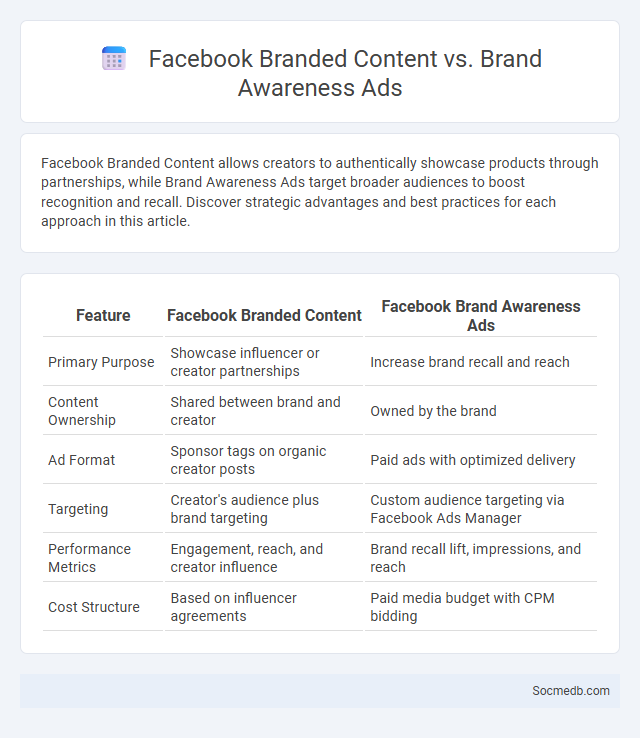
Photo illustration: Facebook Branded Content vs Brand Awareness Ads
Facebook Branded Content allows creators to authentically showcase products through partnerships, while Brand Awareness Ads target broader audiences to boost recognition and recall. Discover strategic advantages and best practices for each approach in this article.
Table of Comparison
| Feature | Facebook Branded Content | Facebook Brand Awareness Ads |
|---|---|---|
| Primary Purpose | Showcase influencer or creator partnerships | Increase brand recall and reach |
| Content Ownership | Shared between brand and creator | Owned by the brand |
| Ad Format | Sponsor tags on organic creator posts | Paid ads with optimized delivery |
| Targeting | Creator's audience plus brand targeting | Custom audience targeting via Facebook Ads Manager |
| Performance Metrics | Engagement, reach, and creator influence | Brand recall lift, impressions, and reach |
| Cost Structure | Based on influencer agreements | Paid media budget with CPM bidding |
Understanding Facebook Branded Content
Understanding Facebook branded content enhances your ability to create authentic partnerships that resonate with target audiences. Facebook's branded content tool allows creators and businesses to tag sponsors directly, ensuring transparency and boosting engagement through trust. Optimizing your posts with relevant hashtags and compelling storytelling increases visibility and drives meaningful interaction on the platform.
What Are Brand Awareness Ads on Facebook?
Brand awareness ads on Facebook are designed to increase the visibility of your business by reaching users likely to remember your brand. These ads use Facebook's algorithm to target audiences with high engagement potential, optimizing the ad delivery for maximum recall. By leveraging visual content and concise messaging, your brand can build recognition and strengthen the connection with potential customers.
Defining Branded Content Across Platforms
Branded content refers to marketing material that is created to promote a specific brand while providing value or entertainment to the audience. On platforms like Instagram, TikTok, and YouTube, branded content often blends seamlessly with user-generated content, leveraging native formats such as Stories, Reels, and sponsored videos. Effective branded content strategies focus on authenticity, audience engagement, and alignment with platform-specific trends to enhance brand visibility and consumer trust.
Key Objectives: Branded Content vs Brand Awareness Ads
Branded content aims to create authentic, engaging stories that foster deeper emotional connections with the audience, driving long-term loyalty and trust. Brand awareness ads focus on maximizing reach and visibility, targeting broad demographics to increase overall recognition and recall of the brand. Both strategies work synergistically to strengthen market presence, with branded content enhancing engagement while brand awareness ads boost exposure.
How Facebook Branded Content Works
Facebook Branded Content allows creators and businesses to tag a brand in their posts, ensuring transparency and enhancing brand visibility. This feature enables brands to reach targeted audiences through authentic content created by influencers, leveraging Facebook's detailed demographic data for optimized ad delivery. By integrating branded content with Facebook Ads Manager, brands can track engagement metrics and increase ROI through precise analytics and audience insights.
Targeting and Reach: Differences Explained
Targeting in social media allows you to precisely connect with specific audiences based on demographics, interests, and behaviors, ensuring your content reaches those most likely to engage. Reach measures the total number of unique users exposed to your content, reflecting the breadth of your campaign's visibility. Understanding the difference between targeting and reach helps optimize your strategy for maximizing engagement and efficient use of your marketing budget.
Content Formats and Creative Flexibility
Social media platforms support diverse content formats including images, videos, stories, reels, and live streams, enabling brands to engage audiences through various mediums. Creative flexibility allows marketers to tailor messages with interactive elements, filters, and user-generated content, enhancing audience interaction and retention. This versatility fosters dynamic storytelling and personalized marketing strategies, optimizing reach and engagement across demographics.
Performance Metrics and ROI Comparison
Performance metrics such as engagement rate, click-through rate (CTR), conversion rate, and follower growth provide critical insights into social media campaign effectiveness. ROI comparison involves analyzing revenue generated versus campaign costs, highlighting channels like Facebook Ads and Instagram Stories that often yield higher returns due to precise targeting and enhanced user interaction. Leveraging analytics tools like Google Analytics and native platform insights ensures accurate tracking and optimization of social media investments.
Choosing the Right Strategy for Your Brand
Selecting the right social media strategy requires understanding your target audience's preferences, behaviors, and platform usage patterns. Leveraging data-driven insights and competitive analysis helps tailor content types and posting schedules that maximize engagement and brand visibility. Integrating brand voice and clear objectives ensures consistent messaging across channels, driving stronger customer relationships and measurable business outcomes.
Best Practices for Leveraging Each Ad Type
Effective social media advertising requires understanding the unique strengths of each ad type to maximize engagement and ROI. Image ads perform best with striking visuals and concise messaging that capture attention quickly, while video ads benefit from storytelling that evokes emotion and keeps viewers engaged longer. Carousel ads allow you to showcase multiple products or features, encouraging interaction, and lead ads simplify the conversion process by enabling users to submit information without leaving the platform, enhancing your lead generation efforts.
 socmedb.com
socmedb.com